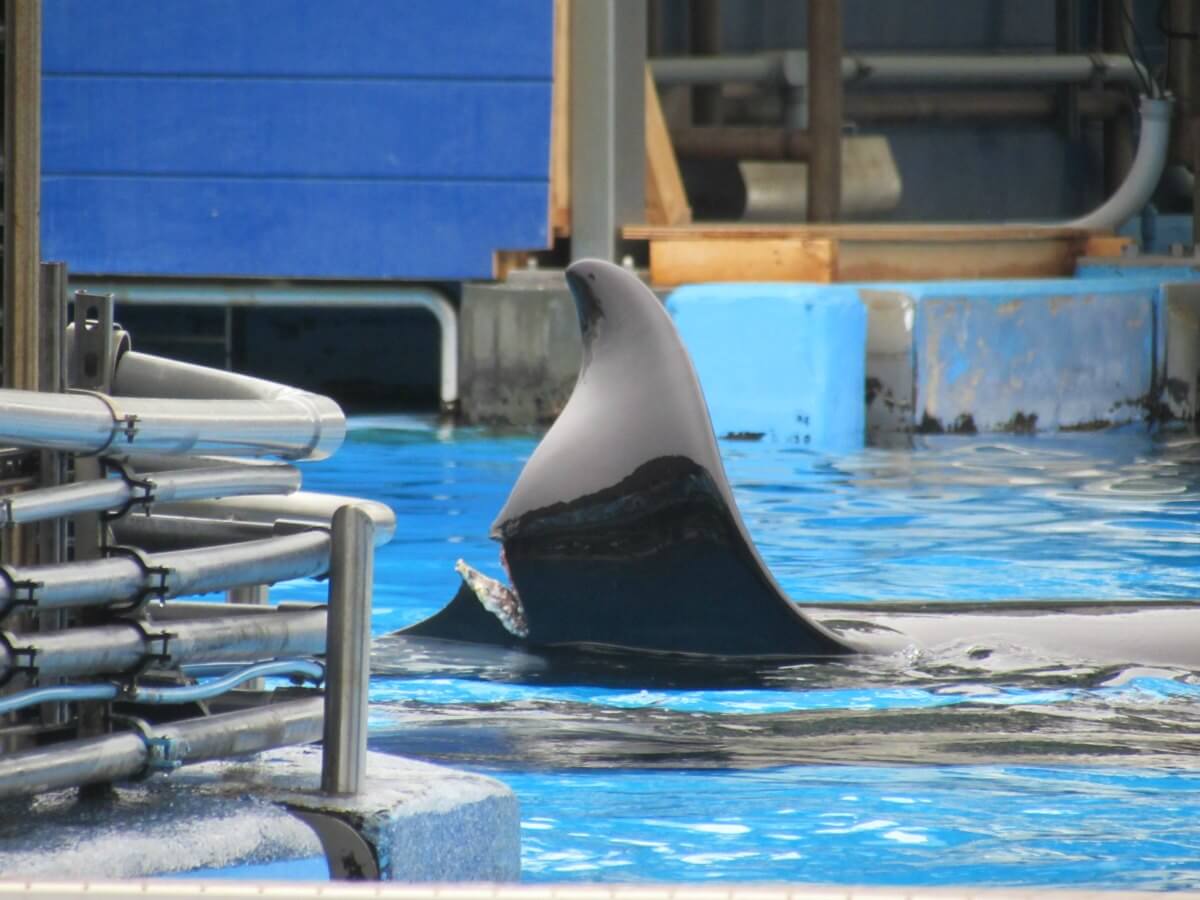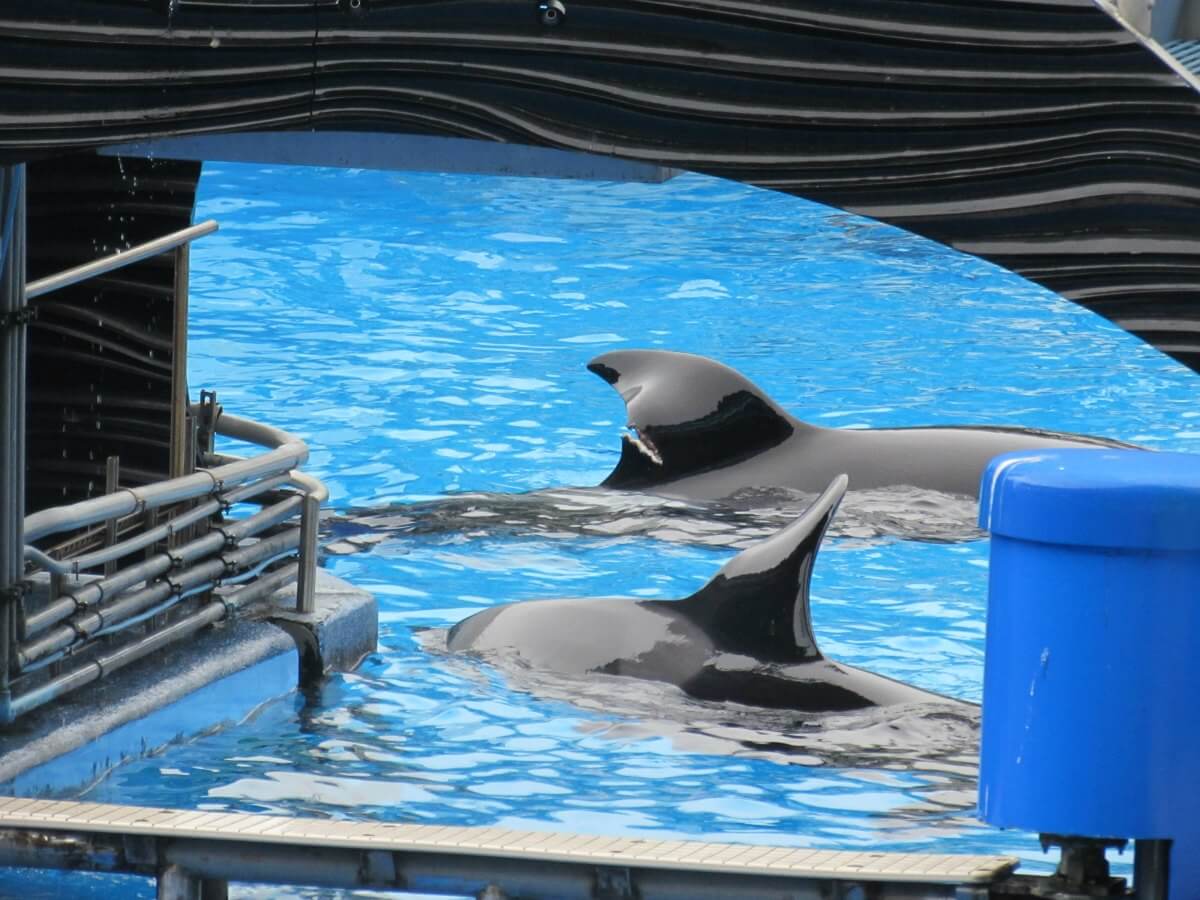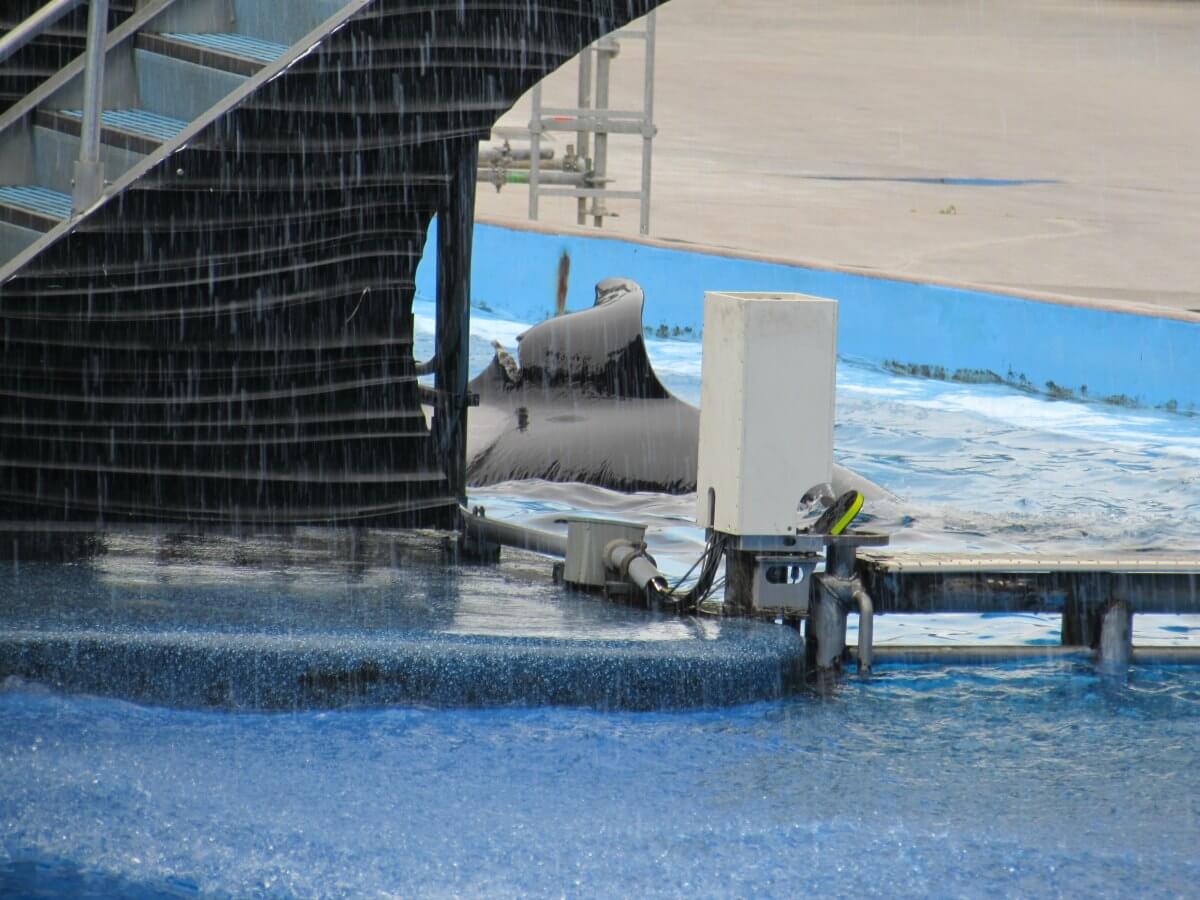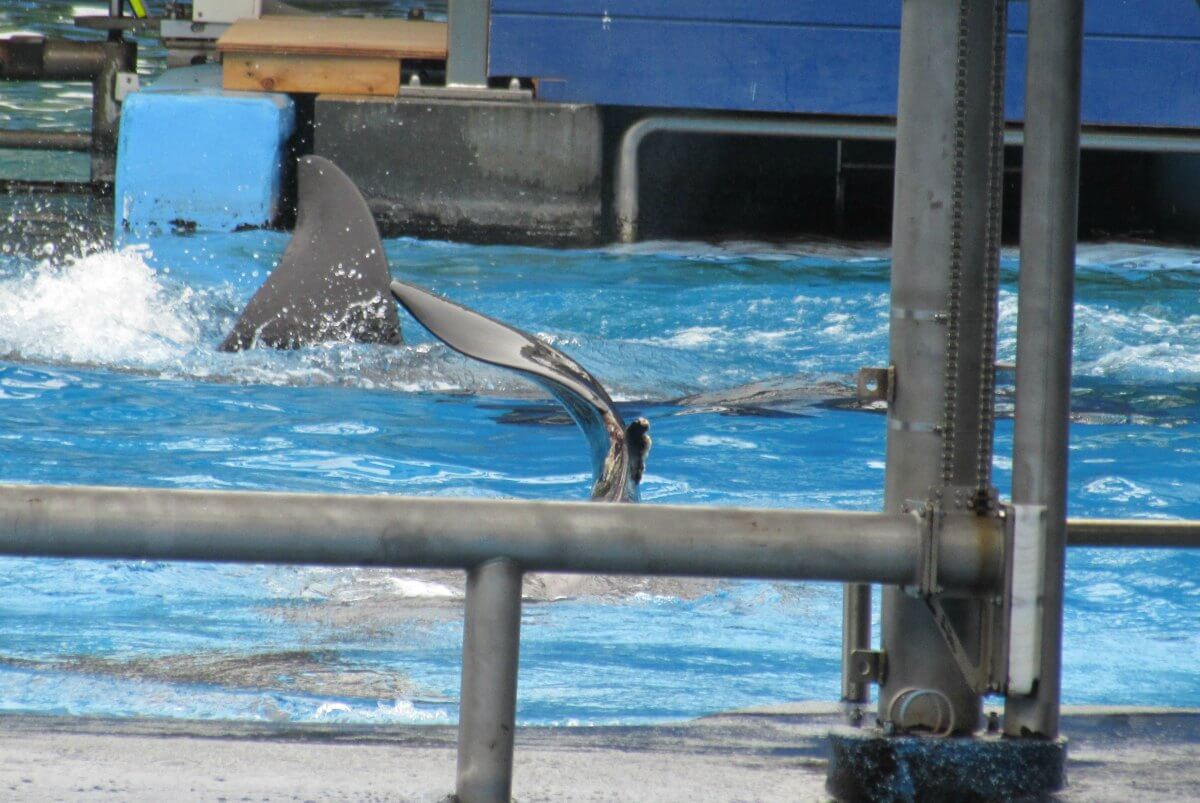'A Whale of a Week' & Your 'Dolphin Outlook', Game of Thrones star Jerome Flynn, Pulling the Plug on SeaWorld Podcast, Orca Katina’s dorsal fin was split open, South Korea Bans to import Taiji's Dolphins, The Gamers for Orcas Challenge, Stopping the Dolphin Slaughter Educational Series & a very special Thanks to Heather Murphy, Ocean Advocate News!
Orca Katina’s Dorsal Fin Split Open at SeaWorld Orlando. Check out the Investigative Pictures taken by Heather Murphy.
 © Heather Murphy, Ocean Advocate News
© Heather Murphy, Ocean Advocate News
Orca Katina’s dorsal fin was split open—a potentially life-threatening injury—during an interaction with incompatible members of her contrived “pod” at SeaWorld Orlando.
As these photos show, the wound is deep and a large chunk of her fin appears to be missing. Orca dorsal fins have an extensive network of blood vessels that help the animals regulate body temperature. And while wild orcas have been known to survive severe trauma to their dorsal fins—such as that caused by being struck by boat propellers—for captive orcas, healing is much harder. Large, open wounds make them particularly susceptible to infections from environmental pathogens. And infections are the leading cause of death among captive orcas. Katina’s life depends on the wound’s successful healing.
 © Heather Murphy, Ocean Advocate News
© Heather Murphy, Ocean Advocate News
SeaWorld is falsely claiming that such interactions between orcas are “a natural behavior we’d expect to see.” But the company likely knows that aggression is rarely observed in podmates in the wild. Captive orcas commonly fight because members of different pods have been taken from their homes and families and crammed into tiny concrete tanks under stressful conditions with strangers who usually don’t even speak the same dialect.
In nature, Katina would be overseeing a family unit comprising several generations of her male and female offspring. She’d teach her pod to navigate vast ocean terrain, speak a distinct dialect all its own, and find food in times of scarcity.
 © Heather Murphy, Ocean Advocate News
© Heather Murphy, Ocean Advocate News
At SeaWorld Orlando, her “pod” consists of only three immediate offspring—one of whom is the result of inbreeding with her son and another of whom is a grandson, who wouldn’t normally live closely with his paternal grandmother in the wild. The remaining two “pod” members—including Malia, who is suffering from an infection that has caused lesions on her body—are completely unrelated.
PETA Foundation Supervising Veterinarian Dr. Heather Rally released this statement to the media:
SeaWorld conveniently claims to keep orcas in cohesive family pods, but in reality, this matriarch orca is held in a tiny concrete tank with five other orcas—only three of whom are related to her—and suffered immensely when a large chunk of her dorsal fin was ripped out. While aggression is rarely seen among family units in the wild, traumatic wounds such as Katina’s are an all-too-common consequence when complex wild animals are forced to live in unnatural, incompatible groups inside tiny tanks. As her life depends on whether or not this serious wound heals, PETA is once again calling on SeaWorld to send the orcas to seaside sanctuaries, where they may live safer, more natural lives.
 © Heather Murphy, Ocean Advocate News
© Heather Murphy, Ocean Advocate News
PETA is lodging a complaint and demanding that the U.S. Department of Agriculture investigate for possible violations of the federal Animal Welfare Act. We’ll also protest outside SeaWorld Orlando on Tuesday at 12 noon to demand that SeaWorld retire the animals it holds captive to seaside sanctuaries, where they can live a more natural life while benefiting from human care for as long as they may need. Orlando residents are encouraged to attend the demonstration, and we ask everyone to tell SeaWorld to empty its tanks now.
South Korea Bans Importation of Taiji's Dolphins. Dolphins caught in Taiji Japan’s notorious drive hunts will no longer be welcome in South Korea. Today, the Ministry of Environment announced a revised bill on the Protection and Management of Wildlife, banning all imports of dolphins captured in such a brutal manner. Dolphin Project Take Action Now



Orca Katina’s dorsal fin was split open—a potentially life-threatening injury—during an interaction with incompatible members of her contrived “pod” at SeaWorld Orlando.
As these photos show, the wound is deep and a large chunk of her fin appears to be missing. Orca dorsal fins have an extensive network of blood vessels that help the animals regulate body temperature. And while wild orcas have been known to survive severe trauma to their dorsal fins—such as that caused by being struck by boat propellers—for captive orcas, healing is much harder. Large, open wounds make them particularly susceptible to infections from environmental pathogens. And infections are the leading cause of death among captive orcas. Katina’s life depends on the wound’s successful healing.

SeaWorld is falsely claiming that such interactions between orcas are “a natural behavior we’d expect to see.” But the company likely knows that aggression is rarely observed in podmates in the wild. Captive orcas commonly fight because members of different pods have been taken from their homes and families and crammed into tiny concrete tanks under stressful conditions with strangers who usually don’t even speak the same dialect.
In nature, Katina would be overseeing a family unit comprising several generations of her male and female offspring. She’d teach her pod to navigate vast ocean terrain, speak a distinct dialect all its own, and find food in times of scarcity.

At SeaWorld Orlando, her “pod” consists of only three immediate offspring—one of whom is the result of inbreeding with her son and another of whom is a grandson, who wouldn’t normally live closely with his paternal grandmother in the wild. The remaining two “pod” members—including Malia, who is suffering from an infection that has caused lesions on her body—are completely unrelated.
SeaWorld conveniently claims to keep orcas in cohesive family pods, but in reality, this matriarch orca is held in a tiny concrete tank with five other orcas—only three of whom are related to her—and suffered immensely when a large chunk of her dorsal fin was ripped out. While aggression is rarely seen among family units in the wild, traumatic wounds such as Katina’s are an all-too-common consequence when complex wild animals are forced to live in unnatural, incompatible groups inside tiny tanks. As her life depends on whether or not this serious wound heals, PETA is once again calling on SeaWorld to send the orcas to seaside sanctuaries, where they may live safer, more natural lives.

PETA is lodging a complaint and demanding that the U.S. Department of Agriculture investigate for possible violations of the federal Animal Welfare Act. We’ll also protest outside SeaWorld Orlando on Tuesday at 12 noon to demand that SeaWorld retire the animals it holds captive to seaside sanctuaries, where they can live a more natural life while benefiting from human care for as long as they may need. Orlando residents are encouraged to attend the demonstration, and we ask everyone to tell SeaWorld to empty its tanks now.
| ||||||
| ||||||
| ||||||
| ||||||
South Korea Bans Importation of Taiji's Dolphins. Dolphins caught in Taiji Japan’s notorious drive hunts will no longer be welcome in South Korea. Today, the Ministry of Environment announced a revised bill on the Protection and Management of Wildlife, banning all imports of dolphins captured in such a brutal manner. Dolphin Project Take Action Now
Imports will also be restricted if the mammals are captured in areas where wild populations are either unclear, or are in decline.
How did a centuries-old relationship between man and dolphin become so corrupt?
In Taiji, dolphins are chased, then driven into the cove for the purposes of capture or slaughter. The hunts are relentless, with countless mammals dying during the drives themselves. Dolphins are listed in Appendix II of CITES – the Convention on International Trade in Endangered Species of Wild Fauna and Flora – meaning they may not be threatened with extinction today, but may become so unless trade is closely controlled.
Dolphin Project has supported our South Korean friends and colleagues for many years in their efforts to ban dolphin imports from Taiji. We extend a warm “congratulations” to Hot Pink Dolphins, Korean Animal Welfare Association and Korean Federation for Environmental Movement of Ulsan on their success. Dolphin Project Take Action Now
The newest release in our Educational Series is titled "Stopping the Dolphin Slaughter." It has been 8 years since the release of the documentary ‘The Cove’ that highlighted the dolphin slaughter in Taiji, Japan, and unfortunately things have not improved. Please review our new Educational Series and take the quiz to help!
If you would like to donate meals to animal shelters for every correct answer to the quiz at the end of the course, please click here to help!
Please check out the Educational Series and if you enjoy it, please consider upgrading to a Premium Membership to support our educational and advocacy work.
From Captivity to Plastic: How Human Actions Impact Orca Whales and What You Can Do.
Orca whales are truly breathtaking animals. Their sheer size, strength, speed, and dignity have inspired countless legends and stories in cultures all over the world. For example, the Tlingit tribe of North America have traditionally viewed orcas as special protectors of humankind. For this reason, the tribe never hunted orcas, despite frequently hunting other whale species. At the end of 2017, an enormous 2,000-year-old geoglyph of an orca was found by archaeologists in Peru, South America. Researchers from the German Archaeological Institute suggested that orcas may have held a supreme status in the mythology of the ancient culture who lived in the area at the time of the geoglyph’s creation.
Wild orcas typically live in tightly bonded matrilineal pods. They remain close to their immediate family members all their lives and can travel up to 100 miles in a single day. This makes them one of the most widely ranging mammals in the world. Their brains are approximately four times larger than human brains, while MRI scans have also revealed that the brain lobes responsible for processing complex emotions are significantly larger for orcas than they are for humans. Wild orcas’ behavior around humans has frequently been observed as surprisingly respectful and gentle: despite their “killer whale” name, there has never been a recorded incident of a wild orca killing a human being.
Sadly, orcas are facing a variety of issues that threaten their survival today.

Putneypics/Flickr
One issue that has left a significant impact on these animals is that they have been targeted for capture and imprisonment by marine parks around the world for decades. One of the most well-known and tragic cases of an orca who dealt with the enormous strain of a life in captivity was that of Tilikum. He was captured off the coast of Iceland in 1983 at the age of two: an event that – by many accounts – left him highly traumatized. At the time of his death on January 6, 2017, Tilikum had spent most of his life in SeaWorld Orlando. On February 24, 2010, he killed his trainer Dawn Brancheau after losing his temper and dragging her underwater during a performance. Tilikum had also been connected with the deaths of two other humans before this.
Brancheau’s tragic death was explored in the 2013 documentary Blackfish. This popular documentary detailed a number of ongoing health and safety concerns that SeaWorld had failed to address prior to Brancheau’s death. It also shone a spotlight on the dubious treatment of orcas and other marine animals at SeaWorld’s theme parks. Following Blackfish‘s release, it was cited by many as the main reason SeaWorld attendance figures and profit margins began to witness a steep decline. The corporation’s most recent CEO, Joel Manby, had to step down earlier this year after failing to improve its tarnished reputation.
An array of both physical and psychological health problems such as dorsal fin collapse, depression, abnormal repetitive behaviors, dental problems (usually caused by the orcas’ repetitive chewing of their enclosure walls or barriers) and aggressive actions are rife among captive orcas. These conditions are virtually never witnessed among wild orcas.
Orcas who dwell in their natural environment tend to live by a sort of “pod code” that prohibits serious aggression among members of the group. When conflict occurs, they have the option of simply swimming away from the situation until tempers have cooled. Sadly, the typical captive tank represents only 0.001 percent of the territory that would be available to an orca in the wild, so captive orcas have no such choice in the matter. Morgan, a young female orca living in Loro Parque amusement park in Tenerife, Spain, has been the victim of frequent bullying, physical attacks and even sexual assaults by her tank mates.
Sadly, human interference with our planet’s oceans has also made life significantly more difficult for wild orcas in recent years.

Rennett Stowe/Flickr
One problem that has caused difficulty for many marine species – including orcas – is our rampant consumption of plastic and our unfortunate habit of using the seas as a dumping ground. We produce an estimated 300 million tons of plastic annually. Of this figure, 8.8 million tons find their way into the oceans each year, where it threatens over 700 marine species with extinction. There are 46,000 pieces of plastic in every individual square mile of the ocean. These pieces of plastic can remain intact for up to a thousand years, before finally breaking down into countless, tiny microplastic fragments, so this problem is not going away anytime soon. We have reported on many sad cases of marine animals dying after ingesting or becoming entangled in our trash.
One wild orca named Lulu died off the coast of Scotland in 2016 after ingesting toxic chemicals. She had also become entangled in a fishing net: representative of yet another problem that afflicts orcas and other marine animals. Overfishing is literally draining the oceans of life, wiping out fish populations all over the world while also killing an untold number of rays, turtles, dolphins, seals, whales and other animals who are caught and killed as unintended “bycatch” species. Lulu is just one of the orcas to have suffered this fate.
How You Can Help
Luckily, there are many ways you can raise awareness of both captive and wild orcas’ plight. Knowledge is power, so by educating yourself on the various issues involved, you are already one step closer to being a powerful force for change. Sharing this post, or one of the articles linked below, is one simple way to help orcas today. You can also take action in your everyday life by keeping an eye out for petitions aimed at helping captive orcas, or by reducing your consumption of plastic – for example, by refusing to take single-use items such as plastic straws or bags in your local store. Check out some of the resources below to get started.
Captive Orcas
- A Look Into How Life for Captive Orcas Differs From Their Wild Counterparts
- 3 Traumatic Experiences Captive Orcas Know All Too Well
- Groundbreaking Bill Proposed in Florida Could End Captive Orca Breeding and Shows Statewide!
- Where Are the World’s 58 Captive Orcas and How Can We Help Them?
Wild Orcas
- 10 Alarming Facts About Overfishing
- Our Oceans Are Running Out of Fish … and 10 Million Tons Get Wasted by Fisheries Every Year
- There Will be More Plastic in the Oceans Than Fish by 2050 – Here’s How You Can Help!
- 10 Percent of All Whales and Dolphins Have Ingested Plastic, and It’s Staying in Their Digestive Tracts
- One Green Planet’s #CrushPlastic Campaign












